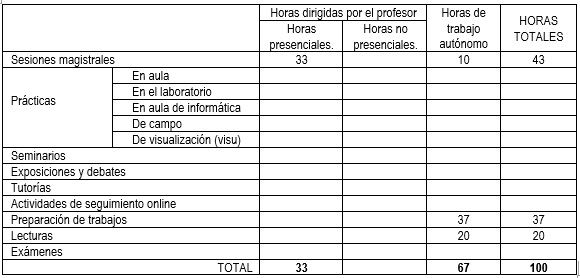TERRORISM, INSURGENCY AND POLITICAL VIOLENCE
GRADO EN ESTUDIOS GLOBALES/GLOBAL STUDIES
Curso 2022/2023
1. Subject Information
(Date last modified: 01-06-22 10:15)- Code
- 109035
- Plan
- 290
- ECTS
- 4.00
- Type
- Opcional
- Year
- 3
- Duration
- Second semester
- Language
- ENGLISH
- Area
- CIENCIA POLÍTICA Y DE LA ADMINISTRACIÓN
- Departament
- Derecho Público General
- Virtual platform
Professor Information
- Profesor/Profesora
- Elena María Gil Moreno
- Group/s
- Único
- Centre
- Fac. Derecho
- Office
- Espacio ACPA, Planta Jardín
- Office hours
- -
- Web address
- https://produccioncientifica.usal.es/investigadores/57649/detalle
- elenagm@usal.es
- Phone
- 923 29 44 00 - Ext. 1617
2. Association of the subject matter within the study plan
Curricular area to which the subject matter pertains.
Political Science
Purpose of the subject within the curricular area and study plan.
Elective, political behavior
Professional profile.
Political Science
3. Prerequisites
-
4. Learning objectives
-
5. Contents
Theory.
Introduction: Political Violence, Theoretical Approaches
Terrorism 1: International and Domestic Terrorism, Stages of Terrorism and Discussion about the Concept of Terrorism
Terrorism 2: Radicalization and Recruitment to Terrorist Groups, Terrorism Databases and Cyberterrorism
Insurgencies: Actor Types, Strategies and Tactics, the Cold War
State Violence: Counterinsurgency and Counterterrorism strategies, Actor Types, and the Political Terror Scale
Criminal Governance: The Mafia and Narco-governments
Practice.
Case studies
6. Competences acquired
Basic / General.
CB2, CB3, CB4 CG1, CG2, CG4
Specific.
CE2, CE15, CE20
7. Teaching methods
Lecture, Seminars, Debates, practical assignments
8. Anticipated distribution of the use of the different teaching methods

9. Resources
Reference books.
- Alonso, R. et al. (2008). Radicalization Processes Leading to Acts of Terrorism, European Commission
- Apter, D. (1997). The legitimization of violence. NYU Press.
- Body-Gendrot, S., & Spierenburg, P. (Eds.). (2008). Violence in Europe. Springer-Verlag New York.
- Brown, M. E., Cote Jr, O. R., Lynn-Jones, S. M., & Miller, S. E. (Eds.). (2010). Contending with Terrorism: Roots, strategies, and responses. MIT Press.
- Calle, L., & Sánchez-Cuenca, I. (2011). What we talk about when we talk about terrorism. Politics & Society, 39(3), 451-472.
- Cockburn, P. (2016). Chaos & Caliphate: Jihadis and the West in the Struggle for the Middle East, Or Books Llc
- Grajales, J. (2013). State Involvement, Land Grabbing and Counter-Insurgency in Colombia (Development and Change), 44(2) pp 211-232
- Hoffman, B. (2018). Inside terrorism. In Inside Terrorism. Columbia University Press.
- Hoffman, B., & Reinares, F. (Eds.). (2014). The evolution of the global terrorist threat: From 9/11 to Osama bin Laden's death. Columbia University Press.
- Johnston, J. (2000). Pedagogical guerrillas, armed democrats, and revolutionary counterpublics: Examining paradox in the Zapatista unprising in Chiapas Mexico. Theory and Society, 29(4), 463-505
- Koppel, T. (2015). Lights out: a cyberattack, a nation unprepared, surviving the aftermath. Broadway Books.
- Lessing, B. (2021). Conceptualizing criminal governance. Perspectives on Politics, 19(3), 854-873
- López, T. M. (2018). Terrorismo y comportamiento político: España y el caso de ETA, Doctoral dissertation, Universidad Autónoma de Madrid
- McMahon, Robert J. (2003). The Cold War: A Very Short Introduction, Oxford University Press
- Mueller, J. (2008). The Atomic Terrorist: Assessing the Likelihood. prepared for presentation at the Program on International Security Policy, University of Chicago, 15.
- National Consortium for the Study of Terrorism and Responses to Terrorism (2020). Global Terrorism Index 2020, Institute for Economics and Peace
- Richards, A. (2014). Conceptualizing terrorism. Studies in Conflict & Terrorism, 37(3), 213-236.
- Sánchez-Cuenca, I., & De la Calle, L. (2009). Domestic terrorism: The hidden side of political violence. Annual Review of Political Science, 12, 31-49.
- Shapiro, J. N. (2013). The terrorist's dilemma. In The Terrorist's Dilemma. Princeton University Press.
- Tilly, C. (2003) The Politics of Collective Violence. New York: Cambridge University Press
- Trejo, G., & Ley, S. (2018). Why did drug cartels go to war in Mexico? Subnational party alternation, the breakdown of criminal protection, and the onset of large-scale violence. Comparative Political Studies, 51(7), 900-937.
- United Nations Office on Drugs and Crime (2012). The Use of the Internet for Terrorist Purposes, United Nations
- US Government (2012). Guide to the Analysis of Insurgency, US Government
- White, J. R., & Clear, T. (2002). Terrorism: an introduction. Stanford, CA: Wadsworth Thomson Learning
10. Assessment
Assessment tools.
- Assignments 40%
- Theoretical assesment tasks 60%
Guidelines in the case of failing the subject.
Evaluation tools will be the same.


